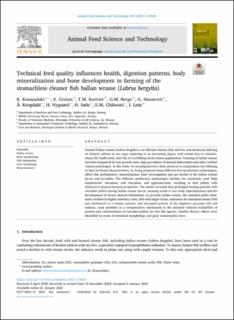Technical feed quality influences health, digestion patterns, body mineralization and bone development in farming of the stomachless cleaner fish ballan wrasse (Labrus bergylta)
Kousoulaki, Katerina; Grøtan, Espen; Kortner, Trond M.; Berge, Gerd Marit; Haustveit, Gunhild; Krogdahl, Åshild; Nygaard, Halvor; Sæle, Øystein; Chikwati, Elvis Mashingaidze; Lein, Ingrid
Peer reviewed, Journal article
Published version
Permanent lenke
https://hdl.handle.net/11250/2762310Utgivelsesdato
2021Metadata
Vis full innførselSamlinger
- Articles [3009]
- Publikasjoner fra CRIStin [3056]
Sammendrag
Farmed ballan wrasse (Labrus bergylta) is an efficient cleaner fish used for non-medicinal delicing of Atlantic salmon in sea cages replacing to an increasing degree wild wrasse due to considerations for biodiversity and risk of overfishing local wrasse populations. Farming of ballan wrasse has been hampered by low growth rates, high prevalence of skeletal deformities and other welfare related pathologies. In this study we investigated how diets identical in composition but differing in their technical characteristics, by being prepared using different feed production technologies, affect fish performance, mineralization, bone development and gut health of the ballan wrasse larvae and juveniles. The different production technologies include the commonly used ‘high temperature’ extrusion, cold extrusion, and agglomeration, resulting in feed pellets with distinctive physicochemical properties. The results revealed that prolonged feeding periods with extruded pellets during ballan wrasse larvae weaning result in low body mineralization and the development of severe skeletal deformities. In juvenile ballan wrasse, the extruded pellet treatment resulted in higher mortality rates, fish with larger livers, indication for increased serum TAG and cholesterol in a similar manner, and increased activity of the digestive enzymes LAP and maltase, most probably as a compensatory mechanism to the assumed reduced availability of protein and carbohydrates of extruded pellets for this fish species. Smaller dietary effects were identified in terms of intestinal morphology and gene transcription rates.
